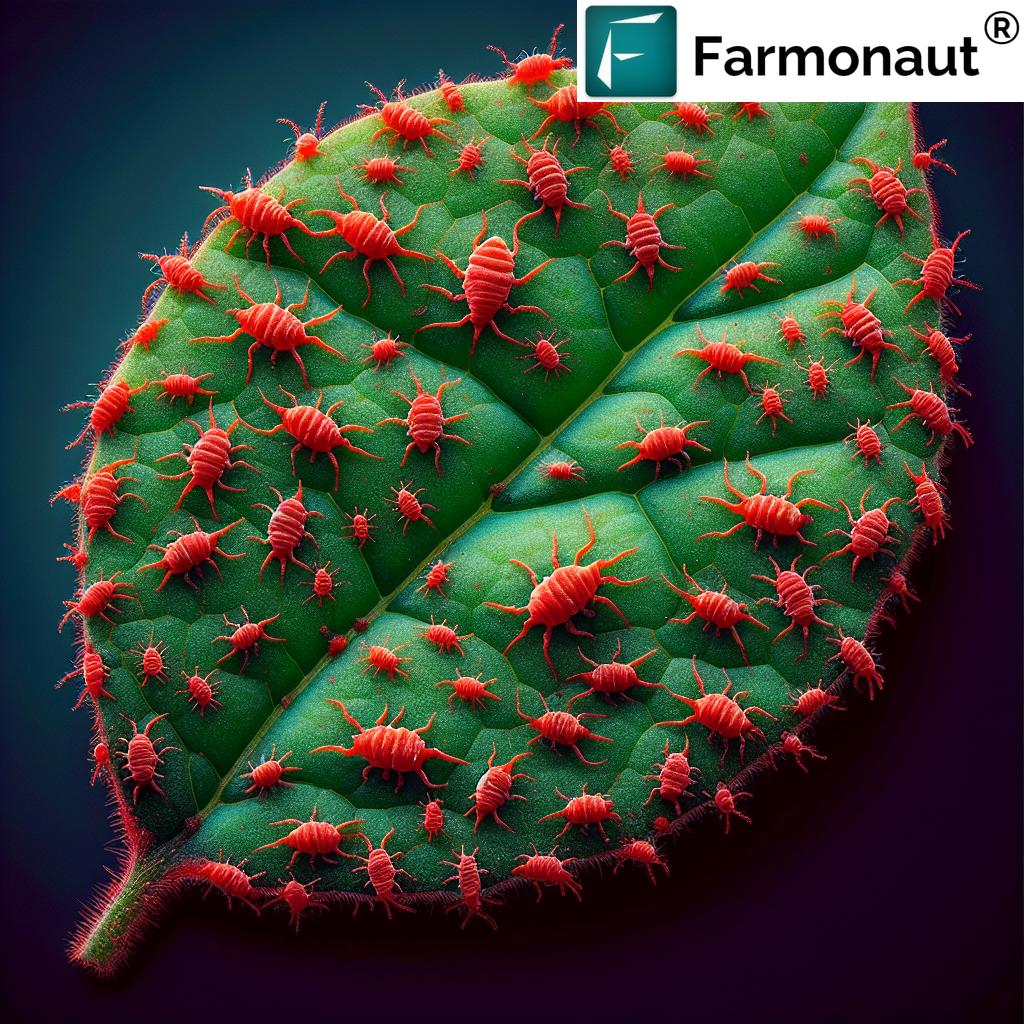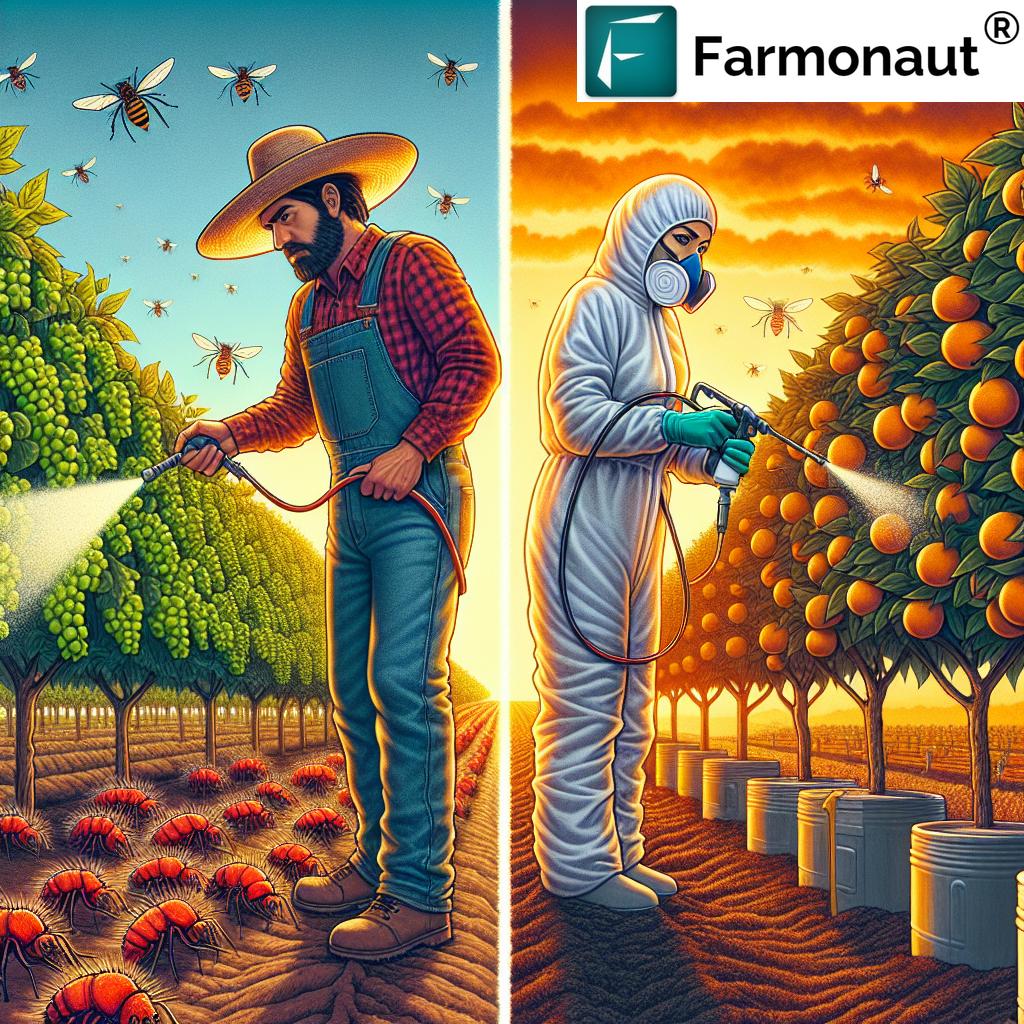Effective Organic Treatment for Red Mites: Controlling Tenuipalpus Granati Infestation on Crops

In the world of agricultural pest management, one of the most persistent and damaging threats to crops is the red mite, particularly the Tenuipalpus granati species. These tiny yet destructive pests can wreak havoc on various crops, including grapes, pomegranate, and citrus fruits. At Farmonaut, we understand the challenges farmers face in combating these infestations while striving to maintain sustainable and eco-friendly farming practices. In this comprehensive guide, we’ll explore effective organic treatments for red mites, focusing on controlling Tenuipalpus granati infestations and preserving crop health.
Understanding Red Mites and Their Impact
Red mites, particularly the Tenuipalpus granati species, are microscopic arachnids that pose a significant threat to various crops. These pests are known for their reddish appearance and their tendency to congregate on the underside of leaves. Their presence can lead to severe damage to plants, affecting both yield and quality of produce.
Characteristics of Tenuipalpus granati
- Size: Extremely tiny, often invisible to the naked eye
- Color: Reddish to brownish-red
- Habitat: Primarily found on the underside of leaves
- Target crops: Common in grapes, pomegranate, and citrus orchards
Signs of Infestation
Recognizing the signs of a red mite infestation is crucial for early intervention. Some common indicators include:
- Yellowing or bronzing of leaves
- Stippling or speckling on leaf surfaces
- Premature leaf drop
- Reduced fruit size and quality
- Webbing on the underside of leaves in severe cases
The Importance of Organic Pest Control
In recent years, there has been a significant shift towards organic farming practices. This transition is driven by several factors, including:
- Consumer demand for pesticide-free produce
- Environmental concerns regarding chemical pesticides
- Long-term soil and ecosystem health
- Regulatory pressures to reduce chemical use in agriculture
At Farmonaut, we advocate for sustainable farming practices that prioritize both crop health and environmental stewardship. Our satellite-based monitoring systems help farmers detect pest infestations early, allowing for timely and targeted interventions using organic methods.
Organic Treatment Options for Red Mites
Controlling red mite infestations using organic methods requires a multi-faceted approach. Here are some effective organic treatments and control measures:
1. Horticultural Oils
Horticultural oils are one of the most effective organic products for controlling red mites. These oils work by smothering the mites and their eggs.
- Neem oil: A natural pesticide derived from neem tree seeds
- Mineral oil: Highly refined petroleum products safe for use on plants
- Vegetable-based oils: Such as cottonseed or soybean oil
Application: Mix the oil with water as per the product instructions and spray thoroughly on the underside of leaves. Repeat applications may be necessary.
2. Predatory Mites
Introducing natural predators is an effective biological control method. Predatory mites feed on red mites, helping to keep their population in check.
- Phytoseiulus persimilis
- Neoseiulus californicus
- Amblyseius andersoni
Application: Release predatory mites onto infested plants, focusing on areas with high red mite populations.
3. Sulfur-Based Sprays
Sulfur is a natural fungicide and miticide that can be effective against red mites when used correctly.
- Wettable sulfur
- Liquid sulfur
Application: Follow product instructions carefully, as sulfur can cause plant damage if applied incorrectly or in hot weather.
4. Diatomaceous Earth
This natural, powdery substance is made from fossilized algae and can be an effective mechanical control for mites.
Application: Dust plants lightly with food-grade diatomaceous earth, paying special attention to the underside of leaves.
5. Botanical Insecticides
Several plant-based insecticides can be effective against red mites:
- Pyrethrin: Derived from chrysanthemum flowers
- Azadirachtin: A compound found in neem seeds
- Rosemary oil
- Clove oil
Application: Follow product instructions for dilution and application. These products often require repeated applications for optimal control.

Implementing an Integrated Pest Management (IPM) Approach
While individual organic treatments can be effective, the most successful control strategies often involve an Integrated Pest Management (IPM) approach. This comprehensive method combines various techniques to manage pest populations effectively while minimizing environmental impact.
Key Components of IPM for Red Mite Control
- Monitoring and Early Detection
- Regular inspection of crops for signs of infestation
- Use of magnifying glasses or hand lenses to spot tiny mites
- Implementing Farmonaut’s satellite-based crop monitoring for early detection of stress signs
- Cultural Controls
- Proper irrigation to avoid water stress, which can make plants more susceptible to mites
- Maintaining plant health through balanced nutrition
- Removing and destroying severely infested plant parts
- Biological Controls
- Introduction of predatory mites and other natural enemies
- Encouraging beneficial insect populations in and around orchards
- Physical Controls
- Use of high-pressure water sprays to dislodge mites
- Pruning to improve air circulation and reduce humidity
- Chemical Controls (Organic)
- Application of organic insecticides and miticides as a last resort
- Rotation of different organic products to prevent resistance development
The Role of Technology in Organic Pest Management
At Farmonaut, we believe that technology plays a crucial role in modernizing and enhancing organic pest management strategies. Our advanced satellite-based monitoring systems offer several advantages in the fight against red mites and other agricultural pests:
Early Detection and Precision Targeting
Our satellite imagery can detect subtle changes in crop health, often before visible symptoms appear. This early warning system allows farmers to:
- Identify potential infestation hotspots
- Target treatments more precisely, reducing overall pesticide use
- Implement preventive measures before infestations become severe
Monitoring Treatment Effectiveness
After applying organic treatments, our technology helps farmers:
- Track the effectiveness of applied treatments over time
- Adjust strategies based on real-time crop response
- Optimize the timing and frequency of applications
Data-Driven Decision Making
By leveraging AI and machine learning, our platform provides:
- Predictive analytics for pest outbreak risks
- Customized treatment recommendations based on crop type, local conditions, and infestation severity
- Historical data analysis to improve long-term pest management strategies
To learn more about how Farmonaut’s technology can enhance your pest management efforts, visit our app or explore our API services.
Comparison: Farmonaut Satellite System vs. Traditional Methods
| Feature | Farmonaut Satellite System | Traditional Methods |
|---|---|---|
| Early Detection | Detects stress signs before visible symptoms appear | Relies on visual inspection, often after symptoms are apparent |
| Infestation Mapping | Precise, satellite-based mapping of affected areas | Manual scouting, potentially missing areas |
| Treatment Effectiveness Assessment | Real-time monitoring of treatment impact | Delayed feedback, often based on visual assessment |
| Cost-Efficiency | Reduces overall pesticide use through targeted applications | Often involves blanket treatments, leading to higher costs |
Best Practices for Applying Organic Treatments
To maximize the effectiveness of organic treatments against red mites, consider the following best practices:
- Timing is Crucial
- Apply treatments early in the morning or late in the evening to avoid rapid evaporation
- Treat at the first sign of infestation for best results
- Thorough Coverage
- Ensure complete coverage of plants, especially the underside of leaves
- Use fine mist sprayers for even distribution
- Regular Monitoring
- Continuously assess pest populations and plant health
- Utilize Farmonaut’s satellite monitoring for comprehensive oversight
- Rotate Treatments
- Alternate between different organic products to prevent resistance
- Combine methods (e.g., predatory mites with horticultural oils)
- Environmental Considerations
- Avoid applying oil-based treatments during hot weather
- Consider humidity levels when using sulfur-based products
Case Studies: Successful Organic Red Mite Control
While we don’t include specific case studies or success stories, it’s important to note that many farmers have successfully controlled red mite infestations using organic methods. These successes often involve:
- Implementing comprehensive IPM strategies
- Consistent monitoring and early intervention
- Combining multiple organic control methods
- Utilizing advanced technologies like Farmonaut’s satellite monitoring
The Future of Organic Pest Management
As we look to the future, the field of organic pest management continues to evolve. At Farmonaut, we’re committed to staying at the forefront of these advancements:
- Improved Formulations: Development of more effective and longer-lasting organic pesticide formulations
- Precision Agriculture: Enhancing our satellite and AI technologies for even more precise pest detection and treatment recommendations
- Biocontrol Advancements: Research into new predatory species and methods for large-scale rearing and deployment
- Integrated Technologies: Combining satellite data with ground-based sensors and drones for comprehensive pest management solutions
Stay updated on these advancements by following our blog and subscribing to our services:
Conclusion
Effective control of red mites, particularly the Tenuipalpus granati species, is crucial for maintaining healthy and productive crops. By adopting organic treatments and integrating them with advanced monitoring technologies like those offered by Farmonaut, farmers can achieve superior pest management while adhering to sustainable agricultural practices.
Remember, successful red mite control requires a holistic approach that combines various organic methods, regular monitoring, and adaptive management strategies. By staying informed about the latest developments in organic pest control and leveraging cutting-edge technologies, farmers can effectively protect their crops while minimizing environmental impact.
For more information on how Farmonaut can help you implement effective organic pest management strategies, visit our website or download our app:
FAQs
- Q: How do I know if my crop is infested with red mites?
A: Look for yellowing or bronzing of leaves, stippling on leaf surfaces, and check the underside of leaves for tiny reddish mites. Farmonaut’s satellite monitoring can also detect early signs of stress caused by infestations. - Q: Are organic treatments as effective as chemical pesticides for red mite control?
A: When applied correctly and as part of an integrated pest management strategy, organic treatments can be highly effective. They also offer the benefits of being environmentally friendly and safe for beneficial insects. - Q: How often should I apply organic treatments for red mites?
A: The frequency depends on the specific product and infestation severity. Generally, treatments should be applied every 7-14 days or as directed on the product label. Continuous monitoring helps determine the optimal application schedule. - Q: Can I use multiple organic treatments simultaneously?
A: Yes, combining treatments like predatory mites with horticultural oils can be very effective. However, always ensure compatibility between different products and methods. - Q: How does Farmonaut’s technology help in red mite control?
A: Our satellite-based monitoring system detects early signs of crop stress, allows for precise mapping of infestations, and helps track treatment effectiveness, enabling more targeted and efficient pest management strategies.
By implementing these organic strategies and leveraging advanced technologies, farmers can effectively manage red mite infestations while maintaining the health and productivity of their crops. Remember, successful pest management is an ongoing process that requires vigilance, adaptability, and a commitment to sustainable farming practices.